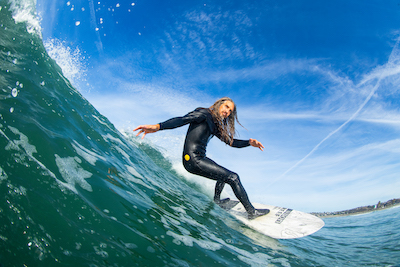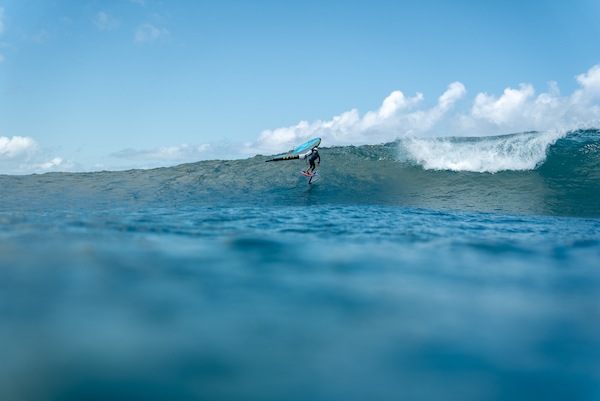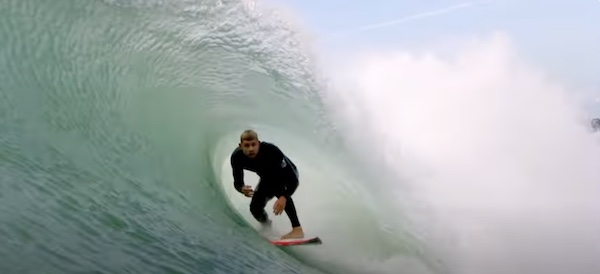When it comes to learning how to foil, there is a lot to know. That's why taking time to understand the process and your equipment is so important. Here is a quick start-up guide from NSP pro riders Franz Orsi and Alex Bicrel to help you choose the right equipment, location and wave to catch your first flight on foil. Read ON for a GIVEAWAY OFFER from NSP!
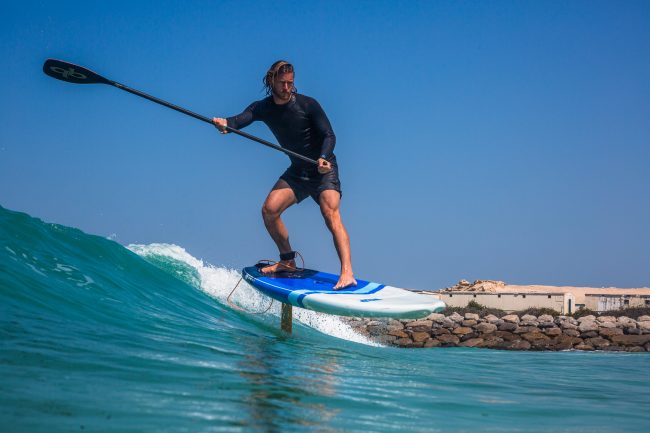 Learning to foil takes a slow, steady effort to make that first transition to foiling on a breaking wave ... even if its in Dubai in a local's paradise. Photo by: NSP/David Edmondson
Learning to foil takes a slow, steady effort to make that first transition to foiling on a breaking wave ... even if its in Dubai in a local's paradise. Photo by: NSP/David EdmondsonFirst Flight on Foil: Choosing the Right Equipment
Whether you're planning to learn SUP foiling, prone surf foiling or wingfoiling, remember; there's a reason why brands develop specific foiling gear. That’s because the right gear for a particular watersport makes everything easier. I spent so much time trying to learn SUP foiling with an old paddleboard that I’d adapted for foiling. Haha...that was definitely a bad decision. It slowed down my learning curve so much that I almost considered quitting at a certain point. So, choose the right equipment by looking at entry-level foil boards or full foil packages that are generous in size, with fat boxy rails and tail, a compact outline and low rocker line. Many companies - like NSP -are taking the guess work out of it for you by creating beginner board + foil packages to get you on the water sooner.
ENTER to WIN your FIRST FLIGHT FOIL PACKAGE from NSP
When it comes to your first foil purchase, choose a relatively short mast (around 65-70cm), a generous front wing surface (1700-2000sq cm for SUP or prone surf foiling) and (1300-1700cm) for wing foiling. This will allow you to drastically improve your learning curve.
The two packages below are priced attractively and will carry you well into intermediate foiling levels, where you can upgrade with more advanced components. Read on for more tips on foot stance, location and safety!
Check out NSP's First Flight Surf Foil package $1285
OR NSP's First Flight Wing Foil Kit $1994
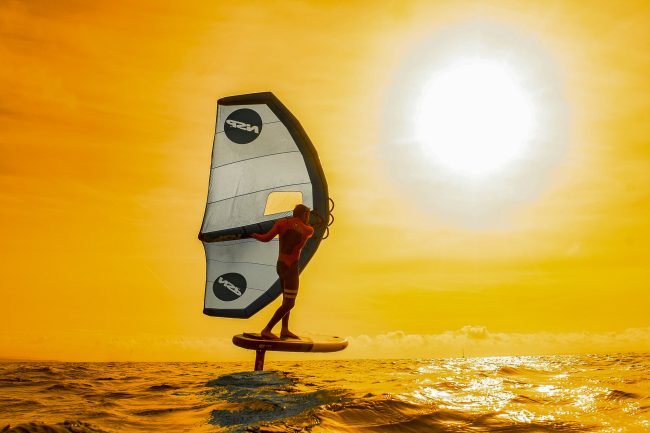 Alex Bickel recommends that when learning to foil, any type of foil, it is best to start behind a boat. That way, riders can learn the nuances of the foil, foot placement and how it responds to speed, chop and other elemental conditions. Photo: NSP/Laurent Nevarez
Alex Bickel recommends that when learning to foil, any type of foil, it is best to start behind a boat. That way, riders can learn the nuances of the foil, foot placement and how it responds to speed, chop and other elemental conditions. Photo: NSP/Laurent NevarezFirst Flights: Choosing the Right Location
Foiling isn't meant to substitute surfing. It is an extension of it. That's why you want to look at waves that would go unridden on regular surfboards. Even if there are athletes out there who are continuously pushing the boundaries of what's possible on a foil, you definitely don't want to learn how to foil on a hollow, punchy wave! This is total nonsense and quite dangerous.
ENTER to WIN your FIRST FLIGHT FOIL PACKAGE from NSP
Instead, you want to look for waves that barely break, in deep water so that you don't risk hitting the sea bottom with your foil. Ideally, there should be enough space for a decent length ride before the closeout or you run the risk of hitting the shore. First flights for foiling are all about small waves, or surging water. You want to look for spots where no surfer would go. This will also ensure that you will stay away from the crowds.
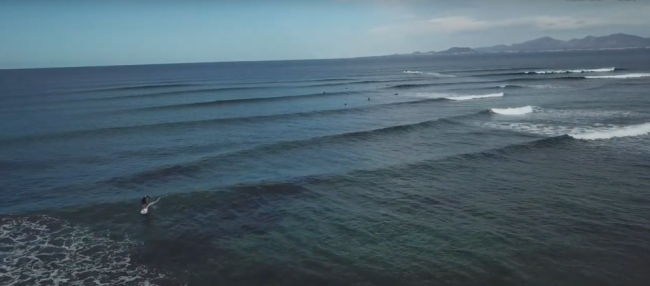 Look for waves where you can have some room for safety. Optimally a wave that breaks into deep water to give you the chance to ride without the worry of hitting bottom. A moment to live the dream on the Canary Islands
Look for waves where you can have some room for safety. Optimally a wave that breaks into deep water to give you the chance to ride without the worry of hitting bottom. A moment to live the dream on the Canary IslandsFirst Flights: Choosing Optimal Conditions to Learn Foiling.
When you’re learning to foil, small, crumbly waves are the best. Your goal will be to catch the whitewater, generate enough speed to pop up to your feet and then slowly increase back-foot pressure to get on-foil. Small, crumbling swells in deep water are the best for any foil beginner. The best conditions include finding a wave that breaks briefly to create a little white water and then fades into deeper water allowing you to take off easily and safely ride in deep water afterwards.
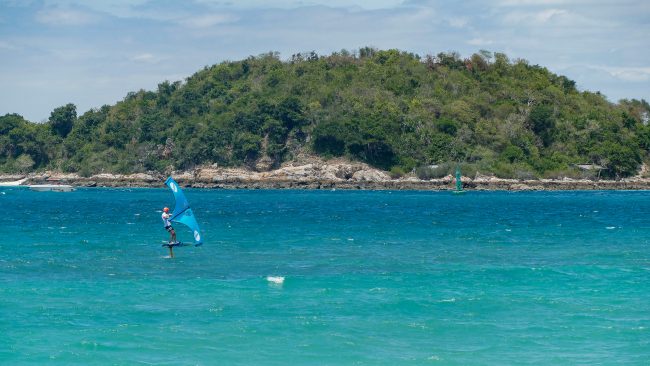 Maxime Hainneville and Capucine Hainneville in Koh Larn Pattaya Thailand.
Maxime Hainneville and Capucine Hainneville in Koh Larn Pattaya Thailand.Safety Tips are Paramount for First-time Foilers.
When learning to foil, safety is so important. Staying away from all other people in the water is mandatory. You need to remember that you have a blade on the bottom of your craft. If you are not a pro, or even acceptable intermediate, you are a danger in crowded conditions. In the beginning, go to spots that are not crowded and always move away from other surfers. It is smart to always wear a helmet, leash, and an impact vest when first learning to ride foil. Foiling is tough and it takes a long learning curve. You will fall off. You will have to dodge your own foil.
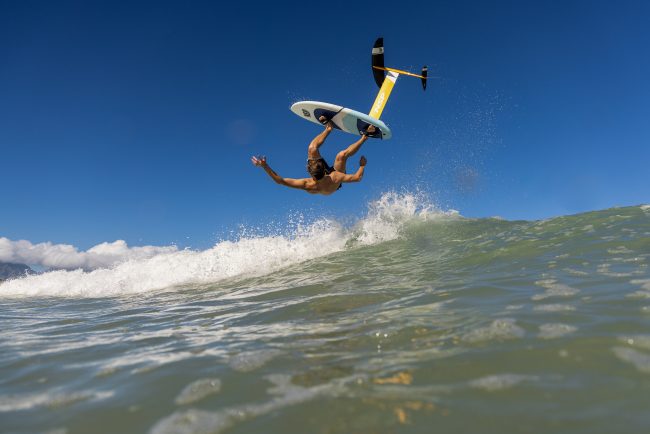
First Flights: Foot Stance and Weight Balance
If you are learning prone surf foiling, your take off will be fairly similar to that of regular surfing. The biggest difference will be the fact that the board will want to, literally, take off! So, be prepared by lying down a bit further forward towards the nose of your board when paddling for a wave. And, push down on the nose as much as possible when popping up on the board. As soon as you stand, apply immediate pressure on your front foot. The steeper the wave is, the more you need to lean forward and keep that nose pressing down. Think of the foil like an underwater airplane. Foot position is key to effectively controlling the different movements of the foil. Therefore, always keep your feet on the stringer and position your back foot on top of the foil as much as possible. A wider stance will also help in maintaining control on lift and flying.
ENTER to WIN your FIRST FLIGHT FOIL PACKAGE from NSP
Remember, most of the time, learning how to foil is hard. Regardless it’s a lot of fun, and once you get it, I guarantee you’ll be addicted. There is nothing else like it.
Good luck,
Franz Orsi
For more on Franz Orsi, click HERE.
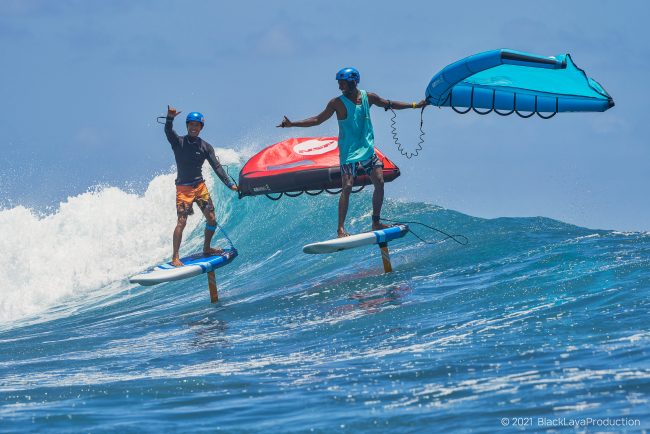
ALEX BICREL
I 100% agree with what Franz said. But I would like to add that if you have the opportunity, always start by learning to foil behind a boat. Just do it. Make the effort to begin here as it will pay off in the long run.
The reason for this is I have seen really good surfers have a super challenging time when they try to learn to foil directly in the waves. It’s different than surfing. The weight balance isn’t the same. The stance might be wider at the beginning. And, you don’t know how the foil is going to respond. This is important.
ENTER to WIN your FIRST FLIGHT FOIL PACKAGE from NSP
To learn behind a boat, I have seen one ingenious system where there’s a bar on the side of the boat and the beginner can hold on that. This gives a lot of stability and the foiler has a lot more control over the foil. It’s basically the same system as when you’re barefoot wakeboarding and the bar is called a barefoot wakeboard tower (if you want to look into it).
Otherwise if you don’t have the chance to get behind a boat, start by finding mellow waves, far from crowds. Make sure the waves are barely breaking with just enough white water to push you and the board into the wave. Once you’re up, you can then ride a rolling bump on the inside to learn how the foil responds rather than trying to surf an actual wave. Go slow. It’s important.
Aloha,
Alex Bicrel

